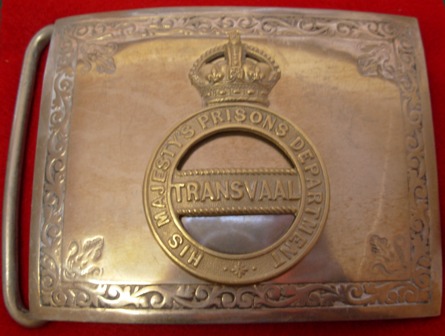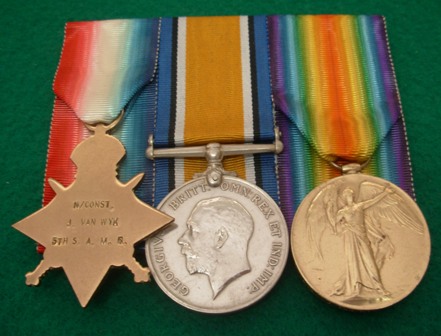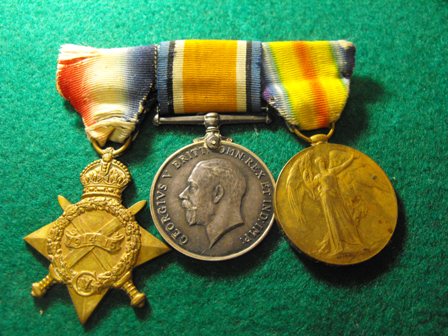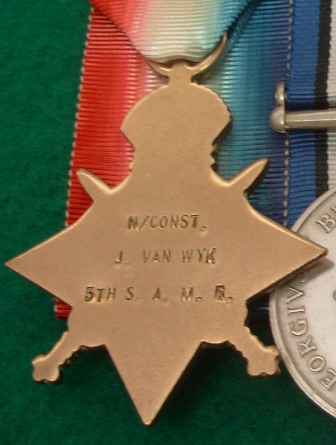
sabrigade
-
Posts
1,707 -
Joined
-
Last visited
-
Days Won
34
Content Type
Profiles
Forums
Blogs
Gallery
Events
Store
Posts posted by sabrigade
-
-
His other brother was a South African Police lieutenant colonel who strangely enough was awarded the OBE in the same gazette that confirmed Archie's CBE award.
0 -
Hi Mervyn
It is the same as the cap badge but the badge on the buckle was manufactured in gilt.
Detail on the uniforms etc of these services are very scarce and I have a number of badges and items in my collection but have not seen a reference to any buckles etc for the other forces.
Regards,
Will
0 -
My opinion, based on the fact that Officers of the SANLC were selected and appointed on their previous experience of working with so-called natives, is that this was the major factor in his appointment and his position in the SANLC. Probably there was very little difference between his military position in the SANLC and civilian appointment in the Public or Civil Service.
All Battalion Commanders in the 1st South African Infantry Brigade were regular combat officers who were specifically selected to lead their battalions in battle on the Western Front.
Godley's position was an administrative one and he was used to plan policies and directives for the SANLC.
His brother was Major General Aleck Godley so this may have also played a part but I am not convinced that it did.
He had married into the Shepstone family which was a very prominent family in the South African civil service and his father-in-law was the Chief Native Commisioner for Natal at the time so he did have an obvious amount of support during his military service and appointment.
0 -

TRANSVAAL PRISONS DEPARTMENT BELT BUCKLE
Part of my collection to the early South African Police and Prisons Services.
0 -
-
-
THE MOST EXCELLENT ORDER OF THE BRITISH EMPIRE COMMANDER (CBE),BRITISH WAR MEDAL 1914 -20, VICTORY MEDAL
Archie Godley was born on 13 October 1871. He was part of a family with strong military conditions. He attended Wellington College but had to seek employment after his father's death in 1889. He moved to Sumatra in the Dutch East Indies and worked on a coffee plantation. This was followed by a move to Siam where Archie was involved in railway construction. In 1893, Godley joined the Cape Mounted Rifles.
After being discharged for being medically unfit in 1895, Godley joined the Natal Civil Service. In 1901, he became an assistant to Sir Godfrey Lagden the Commissioner for Native Affairs in the Transvaal. By 1912, Godley was the Chief Clerk in the Union Government Native Affairs Department.
In September 1916, Archie was commissioned in the SANLC as a Lieutenant Colonel and he duly arrived in France in 1917.
His work with the SANLC was mainly concerned with Headquarters activities. When the SANLC were disbanded, Archie was released from his military service in April 1918 and he returned to the Civil Service. He was awarded the CBE for his services in the SANLC and the decoration was gazetted on 27 June 1919.
0 -
-
BRITISH WAR MEDAL 1914-20, VICTORY MEDAL, WAR MEDAL 1939-45, AFRICA SERVICE MEDAL GROUP AWARDED TO CPL WIEGARDT FOR SERVICE IN WW1 AND WW2
White or European members of the SANLC , all officers and NCO's, were entitled to the normal British World War One campaign medals.
This group is the typical example of a medal recipient to the SANLC.
0 -
BRONZE BRITISH WAR MEDAL 1914 - 20
This South African Native Labour Corps existed from 1916 to 1918. It was raised from the Black populations from South Africa and the High Commission Territories for service in France. The contingents spent specific periods of time in France, a year I think, and rendered very good service. Officers were often selected for their experience in working with the black population. The strength of the Corps is given as 292 Officers, 1404 European Non-Commissioned Officers and 25000 other ranks.
As far as I can determine, NO medals were issued to South African black members of the Contingent and the awards were limted to members from the High Commission Territories - Swaziland, Bechuanaland (Botswana) and Basutholand (Lesotho). Figures vary but it would appear that approximately ONLY 2500 medals were awarded to the SANLC.
The Bronze War Medal was also issued to Chinese, Indian and Maltese presonnel in labour batalions. A total of approximately 110000 of these medals were awarded (Medal Yearbook 2009).
0 -
Hi Dan,
This is one of the many strong points about this Forum.
There are so many aspects that are unclear and after many years of collecting and researching medals and militaria, I realise every day that I am still scratching on the surface!
Regards,
Will
0 -
-
-
-
-
Hi Chris,
I will post my other group today which has the prefix "C" and also a South African Police Long Service Medal with the trio.
I have a "coloured" great uncle who fought in World War One and whose medals I have in my possession.
Regards,
Will
0 -
Hi Tom,
A very pertinent question.
The prefix before his rank 'N" stands for Native which referred to black people in those days.
Constable Van Wyk was probably a man of mixed race as the 5th SAMR was formed from the Cape Mounted Police from the then Cape Province.
I also have a WW1 trio named to a gentleman with the prefix "C" which refererred to Coloured or people of mixed race. They tended to adopt Boer surnames and their home language was Afrikaans or Dutch.
This practice of using prefixes to denote various racial groupings was continued in WW2 where various prefixes can be found on South African issued campaign medals.
There are many questions regarding the issue of these WW1 medals and I hope to gain more insight into the matter, that is one reason why I decided to post this possibly controversial but interesting and unfortunate topic.
Regards,
Will
0 -

MEDALS MOUNTED FOR DISPLAY
0 -
-
http://gmic.co.uk/uploads/monthly_06_2009/post-3034-1245598515.jpghttp://gmic.co.uk/uploads/monthly_06_2009/post-3034-1245598401.jpg
BRITISH WAR MEDAL 1914 -20 AND VICTORY MEDAL
0 -

A great point of contention and debate was and is the issue of campaign medals to non-white South Africans for their service and contribution in World War One.
Approximately 25000 members of the South African Native Labour Corps (SANLC) saw service in France but were not awarded any medals. Approximately 2500 Bronze War Medals were only awarded to the citizens of the neighbouring territories (now Lesotho, Botswana and Swaziland) who were members of the SANLC.
The non-white members of the South African Mounted Rifles (SAMR) and South African Artillery were granted and awarded the standard British campaign medals.
This trio was awarded to Native Constable Van Wyk. I believe that these campaign medals awarded to South African non-whites to be very rare and have only seen this group that forms part of my collection. Van Wyk served in the German South West African campaign.
Members of the SANLC deemed this policy, and I agree totally, to have been grossly unfair. They were very disappointed and resented the fact that despite their sacrifices they were not awarded any medals or even medal ribbons.
0 -
http://gmic.co.uk/uploads/monthly_06_2009/post-3034-1245585083.jpghttp://gmic.co.uk/uploads/monthly_06_2009/post-3034-1245585106.jpg
KHEDIVE'S 1884-6 STAR ISSUED TO A DRUMMER IN THE 3RD BN OF THE GRENADIER GUARDS SHOWING HIS REGIMENTAL NUMBER AND REGIMENTAL INITIALS
William Henry Jackson was a very lively character.
Jackson was also entitled to an Egypt Medal with clasp SUAKIN 1885. Unfortunately, I do not have this medal in my collection.
On his discharge, after 21 years of service, it was noted under the question CHARACTER ON BEING DISCHARGED - "Indifferent,owing to drunkeness and absence".
0 -
Hi Mervyn,
This is one is W/M so may even be of a softer material/metal. Many of the badges I have in my collection and specifically the SAP, show signs of severe rubbing and polishing. Obviously a matter of pride and discipline.
0 -
http://gmic.co.uk/uploads/monthly_06_2009/post-3034-1245560749.jpghttp://gmic.co.uk/uploads/monthly_06_2009/post-3034-1245560405.jpg
Hi Brian,
Some very interesting comments and great items!
I have purchased a few of the Stars here in the Sudan. The "Western" approach to medals and their value and way of wearing them is not always the same in other nations. It is sometimes more common in the Sudan to see medals turned into brooches or necklaces than to be worn on or by the suspender.
I purchased an 1884-6 star in Omdurman with the Tokar clasp and also an undated version and clasp.
I also have a Queen's Sudan medal where the recipient is only entitled to the Khedive Star and clasp but not the Egypt Medal.
The photographs are not the best, I will try to have better ones taken.
Regards,
Will
0

















Order and Medals - Lt Col G.A. Godley, CBE - SANLC
in Great Britain: Orders, Gallantry, Campaign Medals
Posted
A great amount of research was done by a previous collector who owned the group.
In a write up he states:
" On 27 June 1919 the London Gazette published Archie's award of the Commander of the British Empire for service in recruiting the SANLC "
Godley was well known to both Genls Louis Botha and Jan Smuts because of the work he did and the circles both he and his family moved in.